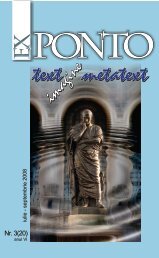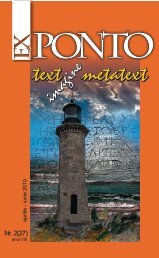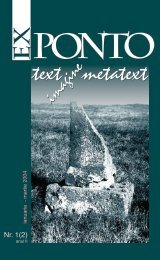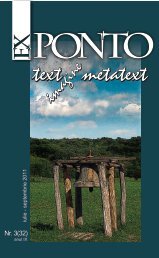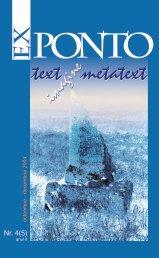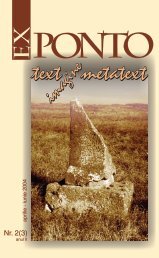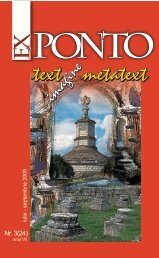Nr. 3 (12) anul IV / iulie-septembrie 2006 - ROMDIDAC
Nr. 3 (12) anul IV / iulie-septembrie 2006 - ROMDIDAC
Nr. 3 (12) anul IV / iulie-septembrie 2006 - ROMDIDAC
- No tags were found...
You also want an ePaper? Increase the reach of your titles
YUMPU automatically turns print PDFs into web optimized ePapers that Google loves.
no definitive point of resolution” 15 , he abandoned them. A different kind offailure to satisfy what authorial intentions seem to represent for the scholars’community is Erdman’s edition of Blake’s complete poetry and prose. Erdmantransformed Blake’s visually rich text into an austere typographical one. Hiscritical edition, however minute and erudite, cannot replace the original iconicityof the text. McGann makes his point when he compares Blake’s attempt tohave all the signifying codes under his control with Byron’s understandingthat it was to his advantage to share authority over bibliographical codes withhis collaborators. The former’s most valuable conclusion regarding authorialintentions is that they “are always operating along with nonauthorial intentions,that each presupposes the other, and that no text ever come into being, orcould come into being, without interactions of the two.” 16One Editorial ErasureMcGann sums it up by saying that, for a long time, authors used to haveauthority over the linguistic code while their editors enforced authority over thebibliographicalal code, although the two codes are both symbolic and signifyingand participate in the communication of the meaning. Adopting his point ofview to comprehend the topic of authorial intensions, one notices that, duringthe process of editing, the most affected code is the bibliographicalal one, theone that seemed to be left outside the author’s authority. McGann does notcomment upon this aspect that would lead the thread back to the discussionof authorial intentions. Somehow, what was conceived as being protected bythe author’s authority was less “damaged” by editors. Paying attention to the“aesthesis of texts” he enumerates the famous examples of textual worksfor which the physicality of the document is inseparable from the linguisticmessage. He names Emily Dickinson’s manuscript book, volumes publishedby Blake, Morris, Whitman, Yeats, W.C. Williams, and Pound. His solution issurprising: texts should be “exhibited” in aesthetic editions like paintings ina museum. He compares Tillotson’s Dickens with Turner’s paintings in theTate Gallery:Both gallery and edition force us to engage with artistic work under aspecial kind of horizon. It is far from the horizon under which Dickens andTurner originally worked. (…) Of course we cannot recover the earlier frameof reference; all we can do is make imaginative attempts at reconstructingor approximating it for later persons living under other skies. The vauntedimmortality sought after by the poetic impulse will be achieved, if it is achievedat all, in the continuous socialization of the texts. 17Ex Ponto nr.3, <strong>2006</strong>Having already underlined the importance of the physical aspect of the text,McGann connects it with the ideology whose mark it becomes. Reconstructingthe context of a textual content, an editor can restore the ideological meaningsimplied by the text’s concreteness. Suddenly, the concrete aspect is no longera support which may be ignored, but an important source of meaning, asinformative as the text itself. Due to the ideological context embedded in texts,the pertinence of the textual physicality cannot be cast out from the editorialjobs. To ignore this aspect means to cut off / erase the text’s ideological,subtle inscription.86






